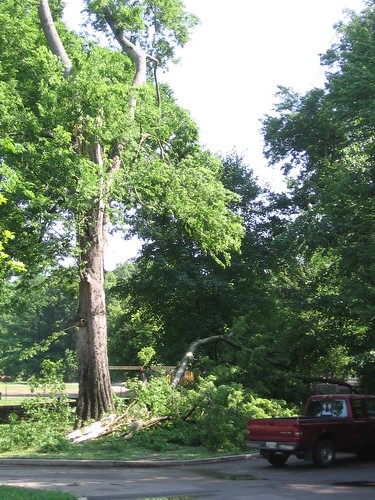Beauty == Utility
The only voice of opposition at the Land Use Control Board's affirmative vote on the Unified Development Code a few weeks ago came from Memphis Light Gas & Water.The utility had a problem with several sections of the code, especially
A. New electric utility services shall be placed underground where functionally feasible...(section 5.3.4)
I seem to remember the MLG&W rep stating that the aesthetics of the code would be a drag on functionality for utilities. A utility's utilitarian argument.
Yet the mass disruptions whipped up by last weekend's storms (mostly by trees and branches falling on above-grade power lines) and the historic storm data exposed by this NOAA map (hat tip Naomi)
 show the impracticality of this opposition. Storms will cross the Mississippi, branches will fall from the sky, above-ground electric lines will get knocked out. But happily, safely, beautifully, increasingly buried electric lines will keep on humming.
show the impracticality of this opposition. Storms will cross the Mississippi, branches will fall from the sky, above-ground electric lines will get knocked out. But happily, safely, beautifully, increasingly buried electric lines will keep on humming.Good aesthetics in tree-rich, storm-happy Memphis is good utility.
Labels: Memphis, Memphis Light Gas and Water, trees, Unified Development Code, urban design, urban planning






8 Comments:
"Utility" is a code word for "cheap to install and repair." In the last several years Memphis has dealt with weather-related weeklong power outages more frequently than many cities on the Gulf coast have been struck by actual hurricanes, yet coastal cities actually, you know, prepare for their inclement weather.
Problems with underground:
--Would cost billions to convert (the cost from overhead damage, even over the past 5-10 years, pales in comparison)
--Massive infrastructure upheaval (digging, street closures, possibly moving sewer/water/gas lines) in places like Midtown
--Underground takes longer on average to restore because you have to dig to locate
--Transformer lines and substations must still be above ground
On the plus side, underground is definitely more resistant to outages from storms like this, though it certainly can experience storm related outages
It's a valid argument and one that virtually every utility in the nation that has overhead lines encounters from time to time.
But the UDC does not require MLGW to retrofit any existing utilities, does it? So we're just talking about new developments, which narrows the field way down.
I'm not clear on why MLGW chose to oppose a clause ("New electric utility services shall be placed underground where functionally feasible...") that seems to contain plenty of wiggle room.
Hear, hear GatesOfMemphis!
I could make quite a thread on the annual MLGW butchery on my parents trees. There's one that they maintain in a U-shape in the side yard. Shame that it has got to go in the long run, but those midtown utility poles will come down when pigs fly.
Yet another example where the first cost decisions override the extended costs of maintenance. Build a city to last a century at least.
thanks guys for the comments.
Stacey, start with the new and take the opportunities as they present themselves to replace the old. Rebuilding Memphis could be a 100 year undertaking. But MLG&W should start the 100 years today, rather than trying to start it 20 years from now.
Naomi, they opposed quite a few parts. I excerpted that part because I heard that underground lines were a key point with them.
re: cost, as an avowed technological progressive I have to think that a technological replacement for highly invasive digging and trenching, ala heart surgeries done without breaking open the chest, has to be on the way.
Much new development is built with underground electric service. However, it's up to the developer in most cases, and sometimes they opt for overhead.
37% of our lines are underground
Cost:
--To put the rest of residential lines underground- about $3 billion
--To put the entire system: $25-30 billion
--We have spent $100 million in the last 20 years in storm restoration
$100 million in storm restoration isn't an accurate metric for economic impact: just spitballing, I estimate an $11 million loss to GDP from Hurricane Priscilla alone.
Post a Comment
<< Home